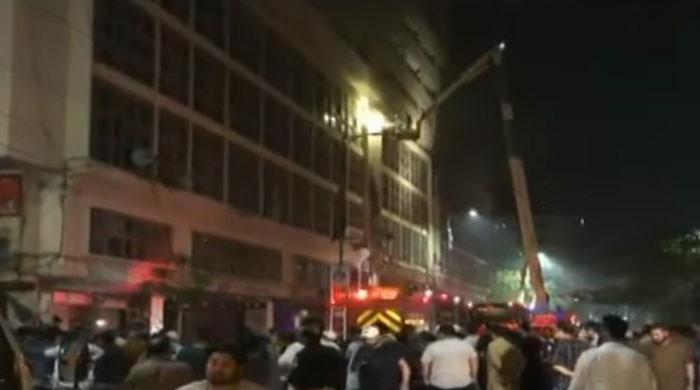IPOR constituency survey finds PML-N leading in Punjab, PTI gaining ground with 50% increase since 2013
Survey findings indicate that PTI largely took away PPP vote in Punjab
July 04, 2018

ISLAMABAD: A constituency-wise survey of entire Punjab has found PML-N maintaining popularity despite ongoing corruption trial of Nawaz Sharif, disqualification of its prominent leaders, and defection of so-called electables.
Although PML-N is ahead with 51% vote bank, it has largely preserved its vote with only a 2% increase in comparison with 2013. This is in contrast with the significant increase in PTI's vote — from 19% in 2013 to 30% in 2018.
The Institute of Public Opinion Research (IPOR) conducted the survey with the biggest-ever sample size of 200,349 respondents from the province. The opinion poll was carried out between April 15 and June 2 this year with a response rate of over 72%. All National Assembly constituencies of Punjab (141) were surveyed with average sample size of 1,420 respondents from each constituency. This is in contrast with most country-wide surveys, where total respondents generally range between 3,000 and 4,000.
According to the survey, the PML-N is ahead of PTI with a 5:3 ratio of voters. The majority of these respondents said load-shedding significantly decreased in the past five years and reposed trust in the performance of their MNAs and MPAs in terms of development work. But respondents also identified three most important issues they face: lack of access to clean drinking water, shortage of gas, and sewerage issues. Health, education, unemployment, and corruption received the lowest scores in their priority list.
Survey findings indicate that the PTI largely took away the PPP vote in Punjab, which has now been reduced to 5% from 11% in 2013, as many PPP leaders switched to PTI in addition to PML-Q leaders. Imran Khan's party is also considered a beneficiary of the fresh vote as 20 million new voters were enrolled after the population census. Tehreek-e-Labbaik with 3% emerged as the fourth largest party, whereas PML-Q and Jamaat-e-Islami have 1% vote each.

Performance of Shehbaz Sharif, despite his general perception as the most efficient chief minister, hasn't been well-received in the public. To a question of how they see the five-year performance of his government, only 28% rated it very good whereas 48% termed it average, 13% considered it bad, and 7% declared it very bad. However, 64% respondents were satisfied with the development work carried out by their respective MNAs and 63% endorsed their MPAs.
Unlike yet another general perception that PTI is very popular among the youth, in particular women, the survey gives the verdict in favour of PML-N.
The majority of voters (46%) fell in the age bracket of 26-40 years. Of the total respondents, 24% belonged to this age bracket and identified themselves as supporters of PML-N compared to 14% for PTI. The second biggest number of respondents (23%) was in the age bracket of 18-25 years. Of the respondents surveyed, 11% fell in this age group and said their vote was for PML-N in comparison with 8% for PTI. 17% of the respondents were 41 to 50 years old, with 9% supporting the PML-N compared to 5% supporting PTI.
If a gender-wise comparison is taken, 34% of the men and 17% of the women support PML-N, whereas 22% male and 8% female respondents said they support PTI.
When surveyors asked about the single-most important issue facing their constituencies, 17% each ticked drinking water and gas, while 16% said it was sewerage. The top three divisions where respondents identified drinking water as the most important issue were Bahawalpur (28%), Sahiwal (25%) and Rawalpindi (22%) respectively. Gas was the most important issue in Rawalpindi (22%), Faisalabad (19%) and Gujranwala (19%), while sewerage was the single most important concern for respondents in Multan (22%), Sargodha (21%), and Faisalabad (19%).
Although health, education, unemployment, and corruption are generally thought to be the most important issues being faced by Pakistanis, three per cent declared health, education, and unemployment each as the biggest concern, whereas one per cent identified corruption. Only 8% pointed towards load shedding as the most important issue.
Responding to a separate question, 67% declared that load shedding had significantly decreased in their respective constituencies in the last five years, 24% said it had not decreased, while 8% didn't respond.

The survey has also mapped the vote bank region-wise. The PML-N has the highest vote in Central Punjab (55%). This is followed by Western Punjab (52%), Southern Punjab (49%), and Northern Punjab (42%).
Meanwhile, the PTI leads in Northern Punjab (31%) and Western Punjab (31%), followed by Central Punjab (30%) and South Punjab (29%). The PPP's highest vote is in South Punjab (8%).
Note from Editor/Disclaimer: Surveys and polls are not always accurate but are useful in capturing trends. Surveys and polls results change as per events and as the Election Day approaches. IPOR is a syndicated survey that includes commissioning by different political parties such as PTI and PML-N and others. It was not commissioned by Jang, GEO, The News











